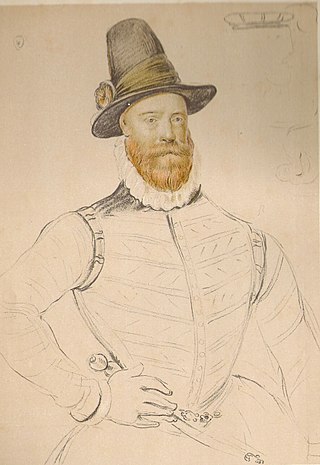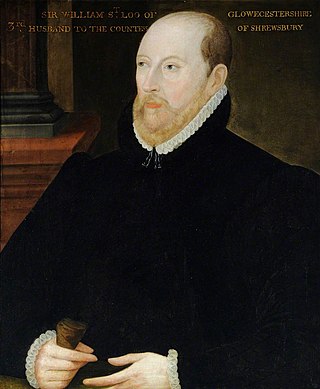
The Battle of Langside was fought on 13 May 1568 between forces loyal to Mary, Queen of Scots, and forces acting in the name of her infant son James VI. Mary’s short period of personal rule ended in 1567 in recrimination, intrigue, and disaster when, after her capture at Carberry Hill, she was forced to abdicate in favour of James VI. Mary was imprisoned in Lochleven Castle, while her Protestant half-brother, James Stewart, Earl of Moray, was appointed Regent on behalf of his nephew. In early May 1568 Mary escaped, heading west to the country of the Hamiltons, high among her remaining supporters, and the safety of Dumbarton Castle with the determination to restore her rights as queen. Mary was defeated and went into exile and captivity in England. The battle is generally considered the start of the Marian civil war.

James Douglas, 4th Earl of Morton was a Scottish nobleman. He played a leading role in the murders of Queen Mary's confidant, David Rizzio, and king Henry Darnley. He was one of the last of the four regents of Scotland during the minority of James VI and I. He was in some ways the most successful of the four, since he won the civil war that had been dragging on with the supporters of the exiled Mary, Queen of Scots. However, he came to an unfortunate end, executed by means of the Maiden, a predecessor of the guillotine.

Matthew Stewart, 4th Earl of Lennox was a leader of the Catholic nobility in Scotland. He was the paternal grandfather of King James VI of Scotland. He owned Temple Newsam in Yorkshire, England.

The Lords of the Congregation, originally styling themselves the Faithful, were a group of Protestant Scottish nobles who in the mid-16th century favoured a reformation of the Catholic church according to Protestant principles and a Scottish-English alliance.

Dumbarton Castle has the longest recorded history of any stronghold in Scotland. It sits on a volcanic plug of basalt known as Dumbarton Rock which is 240 feet (73 m) high and overlooks the Scottish town of Dumbarton.
William Cunningham, 4th Earl of Glencairn, 5th Lord of Kilmaurs was a Scottish nobleman, soldier, and "notorious intriguer".
The Battle of Ancrum Moor was fought during the War of the Rough Wooing in 1545. The Scottish victory put a temporary end to English incursions in the Scottish border and lowlands. The battlefield has been included in the Inventory of Historic Battlefields in Scotland and protected by Historic Scotland under the Historic Environment (Amendment) Act 2011.
Robert Maxwell, 5th Lord Maxwell was a member of the Council of Regency (1536) of the Kingdom of Scotland, Regent of the Isle of Arran and like his father before him patriarch of the House of Maxwell/Clan Maxwell. A distinguished Scottish nobleman, politician, soldier and in 1513 Lord High Admiral, Lord Maxwell was a member of James V of Scotland's royal council and served as Lord Provost of Edinburgh in 1524, 1527 and 1535. He was also an Extraordinary Lord of Session in 1533. In 1537, he was one of the ambassadors sent to the French Court to negotiate the marriage of James to Mary of Guise, whom he espoused as proxy for the King.

The Secret Bond was a document drawn up by Cardinal Beaton and signed at Linlithgow by a number of Scottish peers and lairds on 24 July 1543. They agreed to prevent the marriage of Mary, Queen of Scots, to Prince Edward of England. The document is sometimes called the "Linlithgow Bond".

Kinneil House is a historic house to the west of Bo'ness in east-central Scotland. It was once the principal seat of the Hamilton family in the east of Scotland. The house was saved from demolition in 1936 when 16th-century mural paintings were discovered, and it is now in the care of Historic Environment Scotland. The house now consists of a symmetrical mansion built in 1677 on the remains of an earlier 16th- or 15th-century tower house, with two rows of gunloops for early cannon still visible. A smaller east wing, of the mid 16th century, contains the two painted rooms. The house is protected as a Category A listed building.
Robert Stewart, 1st Earl of Lennox then 1st Earl of March was a Scottish nobleman of the family of Stewart of Darnley.

Sir Adam Otterburn of Auldhame and Redhall was a Scottish lawyer and diplomat. He was king's advocate to James V of Scotland and secretary to Mary of Guise and Regent Arran.
The Battle of Glasgow, 18 March 1560, was fought by supporters of the Scottish Reformation against French troops.

George Douglas of Pittendreich was a member of the powerful Red Douglas family who struggled for control of the young James V of Scotland in 1528. His second son became James Douglas, 4th Earl of Morton and Regent of Scotland. Initially, George Douglas promoted the marriage of Mary, Queen of Scots and Prince Edward of England. After war was declared between England and Scotland he worked for peace and to increase the power of Mary of Guise, the widow of James V.

The siege of St Andrews Castle (1546–1547) followed the killing of Cardinal David Beaton by a group of Protestants at St Andrews Castle. They remained in the castle and were besieged by the Governor of Scotland, Regent Arran. However, over 18 months the Scottish besieging forces made little impact, and the Castle finally surrendered to a French naval force after artillery bombardment. The Protestant garrison, including the preacher John Knox, were taken to France and used as galley slaves.
Alexander Crichton of Brunstane,, was a Scottish Protestant laird who advocated the murder of Cardinal David Beaton and supported the plan for the marriage of Mary, Queen of Scots and Prince Edward of England. In contemporary letters and documents Alexander is known by variant spellings of "Brunstane," his territorial designation. The original House of Brunstane was near Penicuik, and another Crichton estate at Gilberstoun near Portobello, Edinburgh later became known as Brunstane.
Robert Sempill, 3rd Lord Sempill was a Scottish lord of Parliament.

The Cunninghams of Drumquhassle were a family of the landed gentry in Scotland from the early 16th century to the mid-17th. They are linked to the Cunninghams of Kilmaurs in Ayrshire, being descended through junior lines via the Cunninghams of Polmaise. At their greatest extent, their lands included Mugdock-Mitchell and the house at Killermont, covering the part of parishes of Strathblane and New Kilpatrick. John Cunningham, the third laird held several positions of responsibility within the Scottish court, including Master of the Royal Household for James VI and a Collector General of tax during the regency of the Earl of Lennox, but his involvement in the power struggles between the Scottish nobility and the court of Elizabeth I of England also led to his demise and he was executed for treason in 1585. Over the next century, the family lost its land and power – in the mid-17th century, the Cunninghams sold their country house in Drumquhassle in rural Stirlingshire and it passed to the Govane family.

Robert Hamilton of Briggis was a Scottish soldier and military engineer. He was keeper of Linlithgow Palace and Dunbar Castle and was Master of the Scottish artillery.
Mary, Queen of Scots (1542–1587), the daughter of James V of Scotland and Mary of Guise, was crowned as Queen of Scotland in the Chapel Royal at Stirling Castle on 9 September 1543.












